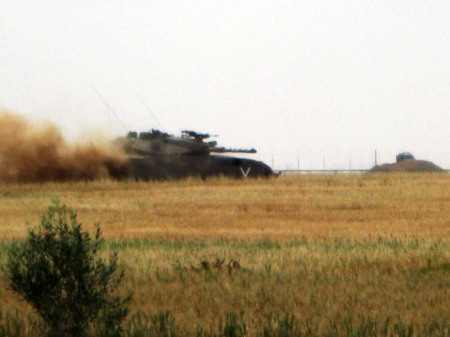Gaza: Watching The Invasion Unfold
By Eva Bartlett
23 April, 2010
In Gaza
It was an early morning, farmers relieved to have harvested the 6 dunam (1 dunam is roughly 1000 square metres) field of lentils planted 5 months ago in Al Faraheen borderlands. The village, east of Khan Younis, includes land cut off to farmers by the Israeli-imposed "buffer zone". That technically 300 metre no-go zone stretching south to north along Gaza’s border with Israel actually extends far beyond the few hundred metres, up to 2 km in some areas where Palestinian civilians have been shot, injured or killed, by Israeli soldiers while on their land.
Abu Qater Tabbash has 100 dunams of land he can no longer access, he says, because it lies in the buffer zone. The land he worked today, along with 5 women from his family, is rented land. Their crop will not pay off, but it will provide lentils for the family and hay for their animals.
"I knew they were going to do something today," says Jaber Abu Rjila. "I saw the bulldozers line up at the border yesterday and knew today there’d be a party," making light of his dangerous reality.

Rjila is an old hand at Israeli invasions, even prior to the one which destroyed his farm and livelihood. Being shot at and having his and neighbouring land churned to waste by Israeli bulldozers is so normal that he continues sorting garlic and harvesting lettuce, to give to his guests, as the tanks line up at the gate before entering and nearing within 200 metres of his home.
But when the bulldozers and tanks begin to thunder in through the Israeli-controlled gate nearest Rjila’s land, he, Leila and a few neighbours are the only ones who stay.
"All of Faraheen will be in Khan Younis after a while," says Jaber, referring to the proximity of the town and the fact that Israeli invasions have repeatedly harassed the citizens of his town, destroyed their houses, shot up their walls and terrified their children.
One of Rjila’s young daughters has never gotten over the experience of being in a house surrounded by and being shot at by Israeli tanks and soldiers as military bulldozers destroyed their land. The girl, just 7 or 8 years old, is slight and shows signs of malnourishment, despite her parents best efforts and the comparative health of her siblings.
"She was traumatized,’ Leila says, explaining that of her siblings, the girl was the most terrified during the 2008 Israeli invasion, which including shelling and gunfire on her home.
The tanks enter the gate some 500 metres from the house we are at and seem to be bee-lining for the Rjila home. When they are roughly 100 metres away, we leave our vantage point, not wanting to bring further wrath on the home by the provocation of documenting Israel’s invasion.
Continuing to film from a different spot still near the home and the convoy of tanks, we hear their rumble as they tear up the earth.

